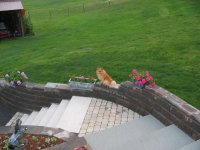I'm planning on constructing some retaining walls on my property. Some of these retaining walls will be 4' in height. I have lots of limestone that I plan on facing these walls with. For the construction of the wall I'm trying to define which direction I should go. I have lots of stone and sand on site and I could potentially by a cheap cement mixer (Lowes $199) and make up my own cement and pour within forms or I could install cinder block and fill. Which would you think would be the lesser expense and lesser labor involved? Either way I still may end up getting a mixer. With block I still need a footer and still need to fill the block but less concrete would be involved.
You are using an out of date browser. It may not display this or other websites correctly.
You should upgrade or use an alternative browser.
You should upgrade or use an alternative browser.
Building a Retaining wall
- Thread starter Airic
- Start date
/ Building a Retaining wall
#1
AlanB
Elite Member
I have two concrete mixers at my house.
If you are doing more than a yard or two of concrete, there are better ways then mixing it yourself, depending on the amount the buggy's or short trucks are cheaper after you buy the Cement.
Is the limestone in sufficient size to just stack with a good angle and build up that way like a castlewall?
As a general statement, when you go past 3' with retaining walls you need to think an engineer a bit more, start doing tiebacks, etc. in there.
Allen Block makes a nice larger block to do those with and the engineering is done for you.
If you are doing more than a yard or two of concrete, there are better ways then mixing it yourself, depending on the amount the buggy's or short trucks are cheaper after you buy the Cement.
Is the limestone in sufficient size to just stack with a good angle and build up that way like a castlewall?
As a general statement, when you go past 3' with retaining walls you need to think an engineer a bit more, start doing tiebacks, etc. in there.
Allen Block makes a nice larger block to do those with and the engineering is done for you.
jdmar
Gold Member
I agree about the engineering needed. I just finished tearing out a sandstone wall (3 tier) that I placed about 2 years ago...it started to slide! I replaced with Alan Block "Europa." The sytem worked great but is detail/labor intensive. But still nowhere near as hard as laying variable sized sandstone/barnstone. For wall over about 3 feet the system uses a geogrid to tie in to the soil behind. You need to dig out about 4 feet behind the wall to compact with this geogrid. It seems to use more stone than the system calculates. I have now placed about 30 pallets of this stuff. They have 4 block sizes in two patterns that makes nice looking wall. I guess you could use a similar geogrid between normal sandstone to help it hold better.
If you have facing stone I would put up block and core-fill. But keep in mind that some of the "pre-engineered" systems like Alan block can hold back better and drain better than poured or block concrete. If you don't need a lot of strength (3 feet with no surcharge) could you just core fill every fourth hole or so and drop rebar? That would save a lot of concrete. If I recall it takes just less than 4 block (8x8x16) for one cubic foot of fill concrete or insulation. I don't know if this helped but I just wanted to share my experiences.
Peter
If you have facing stone I would put up block and core-fill. But keep in mind that some of the "pre-engineered" systems like Alan block can hold back better and drain better than poured or block concrete. If you don't need a lot of strength (3 feet with no surcharge) could you just core fill every fourth hole or so and drop rebar? That would save a lot of concrete. If I recall it takes just less than 4 block (8x8x16) for one cubic foot of fill concrete or insulation. I don't know if this helped but I just wanted to share my experiences.
Peter
2manyrocks
Super Member
- Joined
- Jul 28, 2007
- Messages
- 7,299
Trapped water will topple a retaining wall. People put up concrete block walls on a concrete footer, and you see them leaning 15-20 years later. They are supposed to be anchored into the hillside with adequate drainage. Doing it right involves a lot of materials and work.
